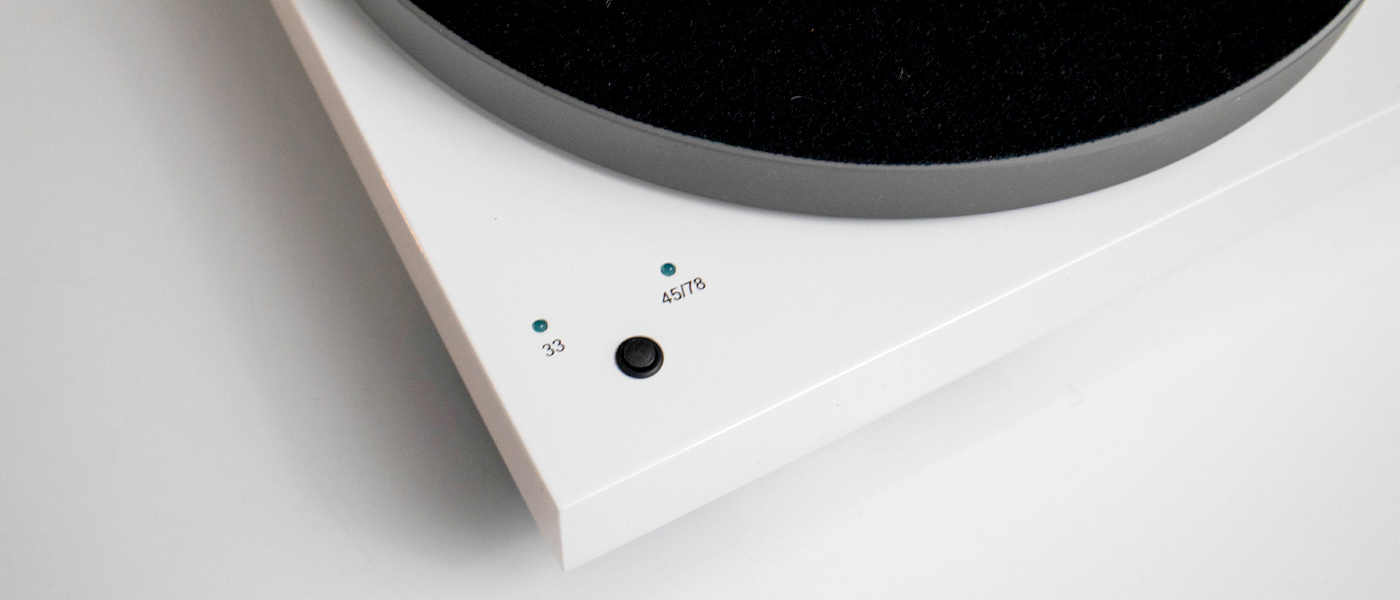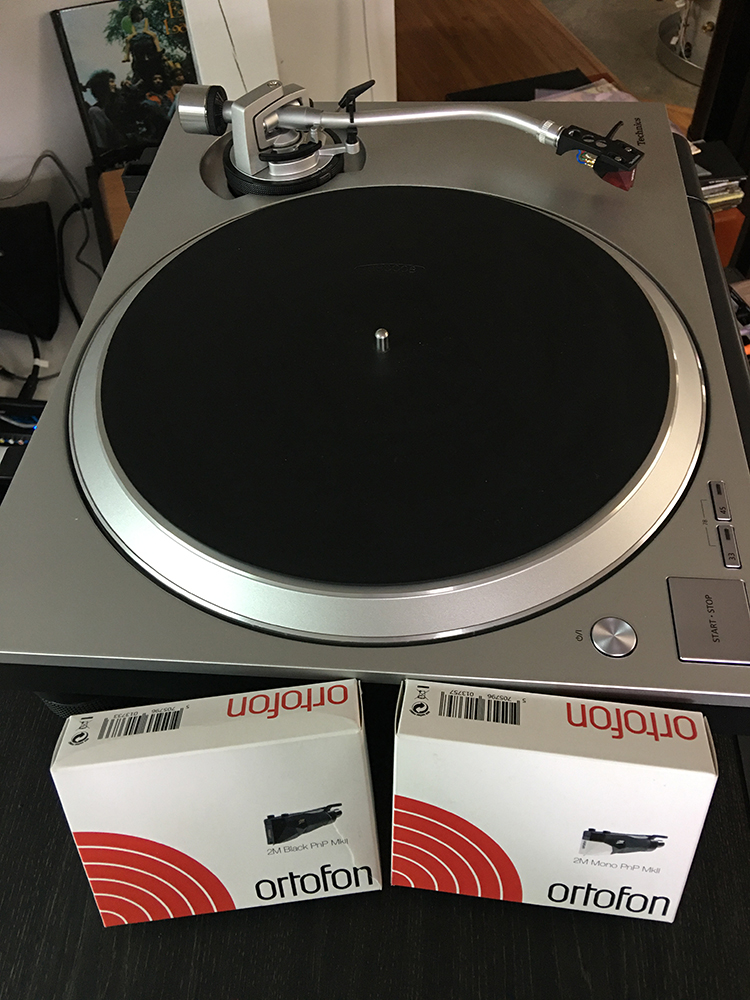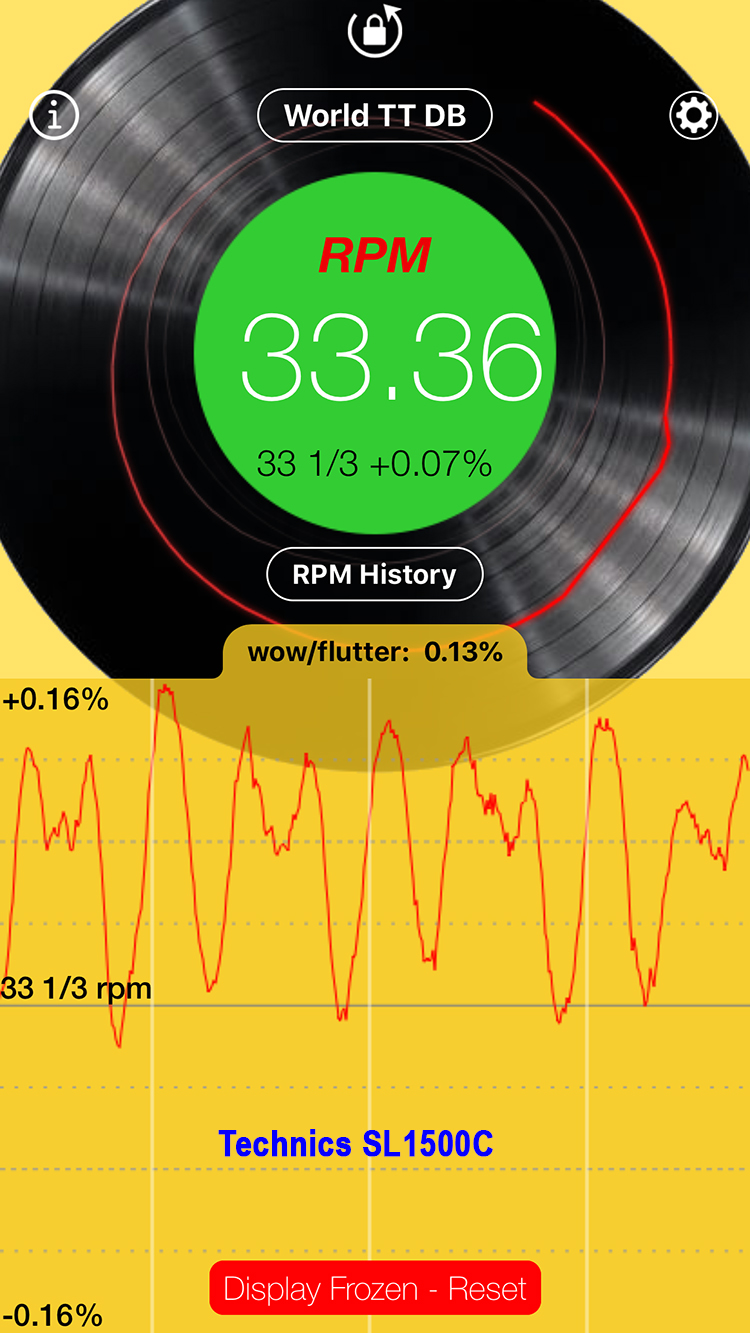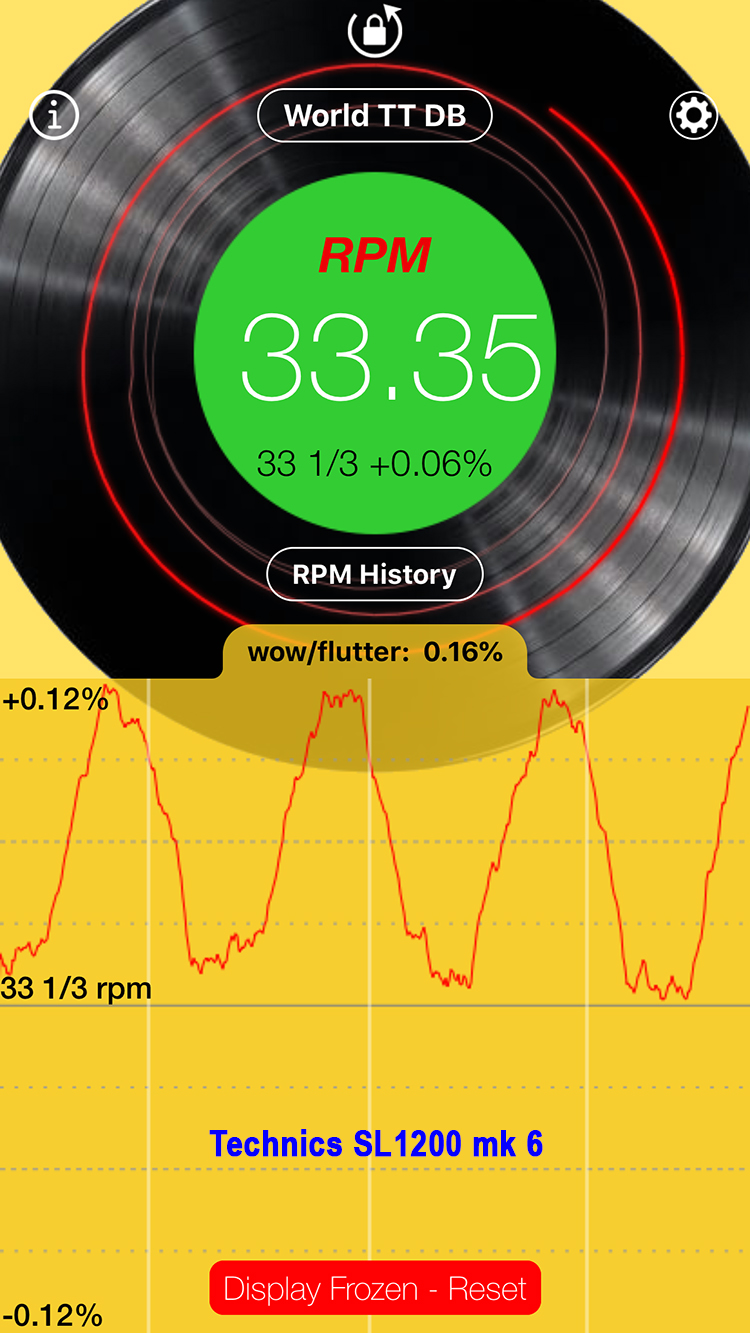
After the release of the “new” SL1200 turntables that heralded Technics’ return to the Hi-Fi marketplace, the company introduced the SL1500C, a platter-spinner that could easily qualify as “everyman’s record player”. It seemingly has all one could ask for to create a true plug-and-play experience for the vinyl neophyte, yet provides plenty of room to grow, should your audiophile aspirations truly take flight.
Technics SL1500C Turntable
- It has the familiar look and build of the classic SL1200.
- Coreless Direct-Drive motor with improved speed accuracy.
- No pitch control slider here.
- Built-in MM phono preamp which can be bypassed.
- Comes with Ortofon 2M Red MM cartridge.
- It will play at 78 RPM too.
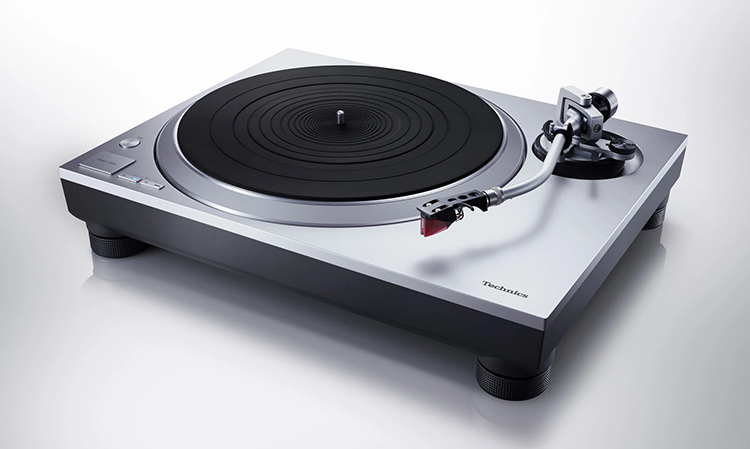
Technics SL1500C Turntable – 3/4 view

Technics SL1500C Turntable – Front view
I first got a chance to see the Technics SL1500C in the flesh at RMAF 2019, which in today’s new normal of COVID-19 quarantine seems almost like a lifetime ago. At first blush, you might think that this is simply a stripped-down SL1200 for the masses. I mean other companies have been knocking out copycat versions of the SL1200 for years taking advantage of the look and the formula that Technics pioneered back in the 1970s. The SL1500C is a whole different story, however. It’s a solid and properly built Technics table with drive innovations that have trickled down from the new 1200s and the Reference Class SL1000R. It has the classic S-Shaped tonearm with the easily interchangeable headshell connection and clear access to all necessary adjustments. It has a built-in MM phono preamp that you can easily bypass if you wish, RCA output jacks so you can use the connection cables of your choice, a removable AC power cable, plus an included Ortofon MM phono cartridge. It also does away with the pitch control, strobe and cueing lights of the SL1200 but gives you 78 RPM playback ability that the SL1200 never had (save for a Japan market Mk 4 model).
Secrets Sponsor
I got into playing vinyl only in the last 4-5 years. My father-in-law, followed by some other retiring friends, gave me their record collections as they were either downsizing or clearing out unused things. I suddenly found myself in the possession of dozens of LPs, many were great jazz, blues and classical recordings that were well preserved, and I had no way to enjoy them. I always wanted to own a classic SL1200 table and, after some research, I purchased a lightly used Japan market SL1200 Mk 6 off eBay and sent it over to turntable specialists KAB Electroacoustics where it was properly reconditioned and had some performance upgrades installed. While I will not get into the whole digital versus vinyl debate here, I find that I do enjoy listening to these classic records that have come into my life and my SL1200 plays a huge part in that enjoyment. Had this set of circumstances happened a few years later than it did, the SL1500C would have certainly been high on my list to consider purchasing with the feature set that it has. I’m curious to see how the two compare in real-world use.
Technics SL1500C Turntable
Design:
Direct Drive Manual Turntable with tonearm and cartridge
Speeds:
33, 45 and 78 rpm via push-button selection
Wow & Flutter:
0.025% WRMS (manufacturer)
Downforce Range (VTF):
0 – 4 grams
Tonearm Length:
9 and 1/16th -inches
Tonearm Type:
Aluminum Universal Static Balance, S-Shaped with Gimbal suspension
Plinth:
Cast Aluminum internal chassis with ABS/Glass Fiber composite outer layer
Platter:
Die-Cast Aluminum with rubber underlayer and rubber mat
Built-In Phono Preamp:
Yes, for MM cartridges only
Supplied Cartridge:
Ortofon 2M Red, Moving Magnet
Accessories:
Turntable sheet, Dust cover, EP record adapter, Counterweight, Auxiliary weight, Headshell, Cartridge (Ortofon 2M Red), PHONO cable, PHONO earth lead, AC power supply cord, Owner’s Manual
Colors:
Silver with Black Base, All Black
Dimensions:
17-27/32 W × 6-21/32 H × 14-21/32 D (inches)
Weight:
21.2 pounds
MSRP:
$1199.99 (including cartridge)
Website:
Ortofon 2M Red Cartridge
Design:
Moving Magnet Phono Cartridge
Stylus Tip:
Bonded Elliptical Diamond tip
Stereo Output:
5.5 mV @ 1 kHz
Frequency Response (Manufacturer):
20 Hz – 20 kHz (+3 dB/-1 dB)
Channel Separation (Manufacturer):
22 dB @ 1kHz
Recommended Tracking Force:
1.6 – 2.0 grams (1.8 grams recommended by Ortofon)
Recommended Resistance Loading:
47 kOhms
Recommended Capacitance Loading:
150-300 picofarads/channel (includes tonearm wiring and phono preamp input capacitance).
Cartridge Height:
18.0 mm
Weight:
7.2 grams
Website:
SECRETS Tags:
technics, turntable, direct-drive, sl1500, ortofon, Turntable Review 2020
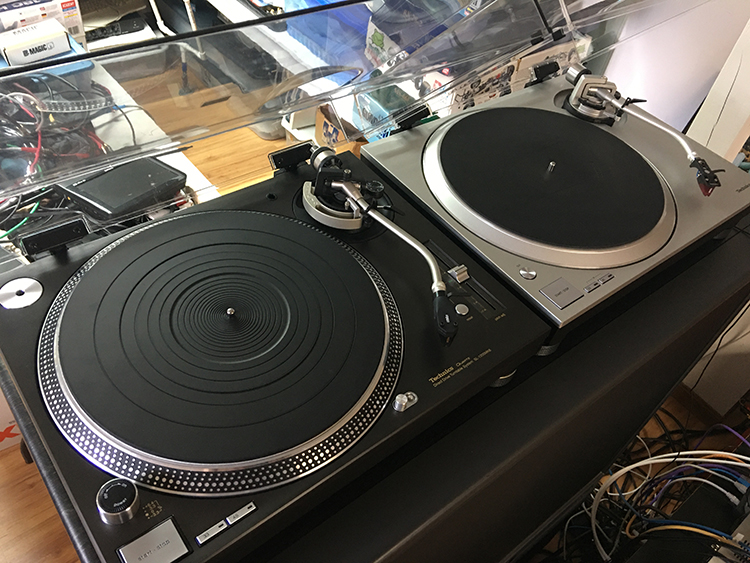
Technics SL1200 Mk 6 and SL1500C – side by side
Let’s get right down to it then, at first glance, the Technics SL1500C looks very much like an SL1200 in both appearance and construction. Looking closer you’ll find that it does without the 1200’s sliding pitch control, the strobe and DJ lights, the platter strobe dots and about 5 lbs worth of gross weight (it weighs in at 21.2 lbs versus the 26.4 lbs of my SL1200 Mk 6). And honestly, unless you were planning to moonlight as an aspiring club DJ, you won’t miss any of these things. What the SL1500C gains over my classic table is a removable grounded power cord, RCA output jacks instead of fixed wire connections, a built-in (can be bypassed) MM phono preamp, a detachable grounding wire (not needed when using the built-in phono pre), an end of LP auto tonearm lift feature (also defeatable), and 78 RPM record playability.
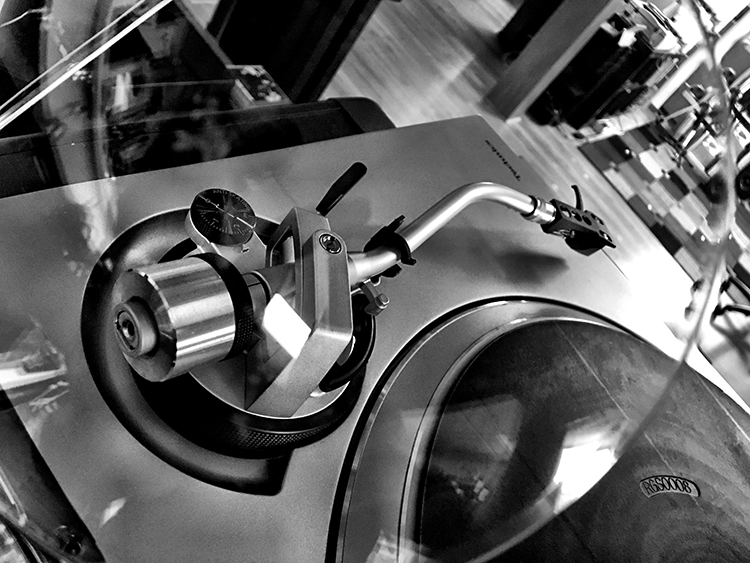
Technics SL1500C Tonearm – rear view

Technics SL1500C Tonearm – VTF and Anti-Skate adj.
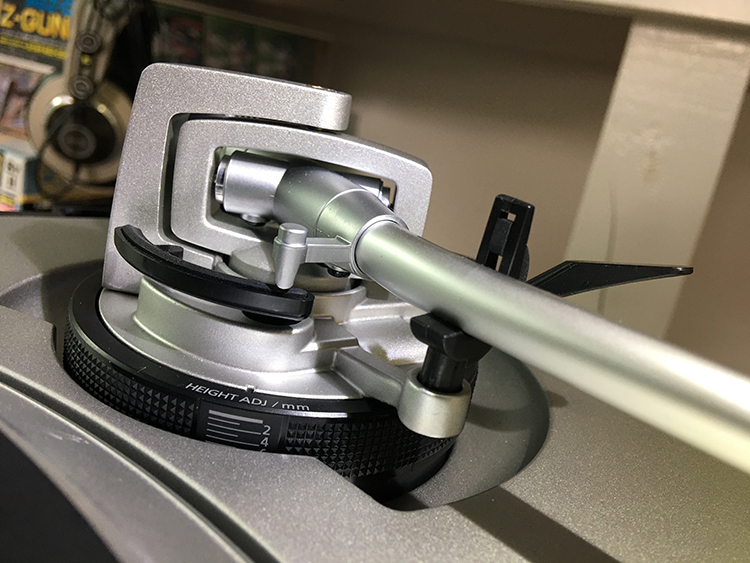
Technics SL1500C Tonearm – Height adj.
The tonearm height adjustment also works a little differently on the new SL1500C. Whereas the old (and new) SL1200 tables have a large ring at the base of the tonearm that unlocks and turns to adjust the height, the SL1500C allows you to unlock a similar looking ring, but this one doesn’t twist. You grasp it and just raise or lower the entire tonearm assembly manually, locking it in place when you arrive at the desired height indicated by a graduated scale on the front of the ring. The tonearm maintains the ability to quickly swap the traditional Technics style headshells.
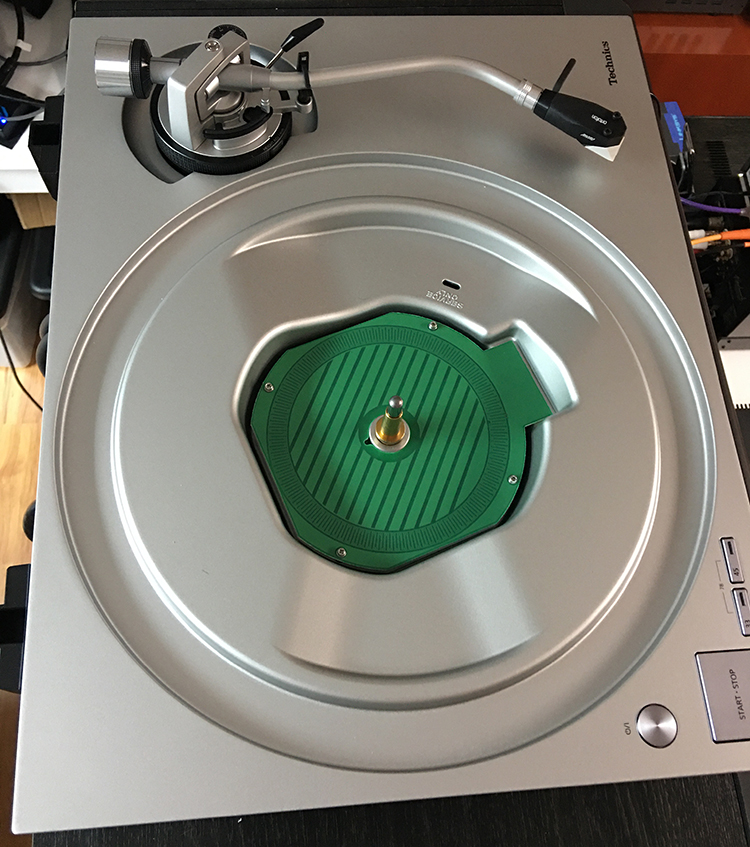
Technics SL1500C – Motor Assembly
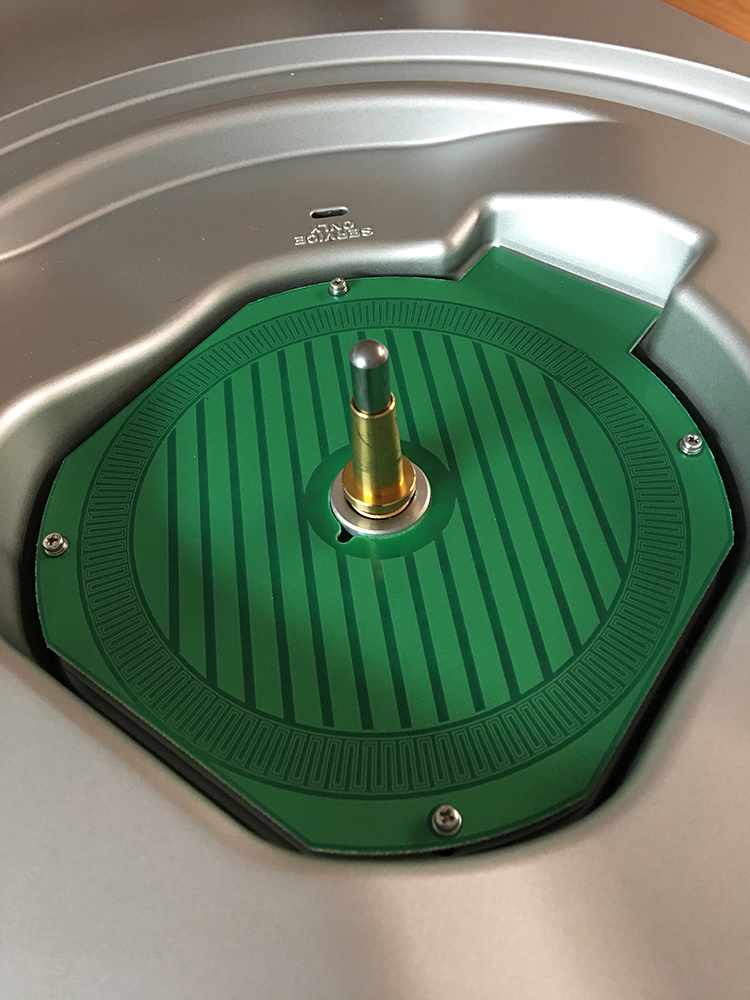
Technics SL1500C – Motor Assembly Close up
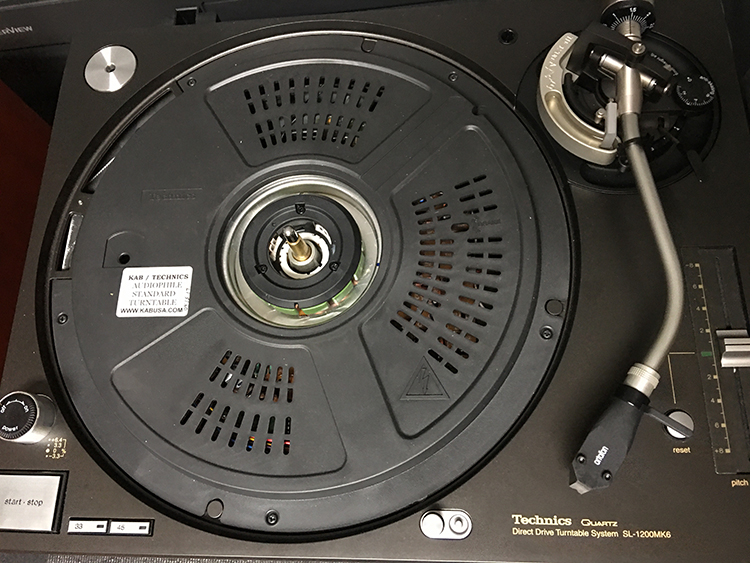
Technics SL1200 Mk 6 – Motor Assembly
Beyond the more obvious surface differences, there is more new stuff happening within the turntable too. The new coreless direct-drive motor is now a self-enclosed unit with no exposed parts. Technics claims that the removal of the old-style steel-based motor core, while increasing the power of the rotor magnets and optimizing the distance between the magnets and stator coils, results in increased torque and eliminates the possibility of “cogging” (a motor induced vibration issue that affected speed stability in older direct-drive systems). The new self-contained motor system is also said to be longer-lasting and more reliable while being easier to repair or replace if required. The new system makes for an interesting comparison to the exposed coils and motor core structure of the direct drive system in my table.
Secrets Sponsor
The other new part of the direct drive system is the micro-controller used to regulate and ensure the constant speed accuracy of the motor. Back at RMAF 2019 I spoke with Tetsuya Itani, CTO and Chief Engineer with Technics and he went into great detail about this feature. Adapted from Blu-Ray player drive systems, the controller essentially monitors and analyzes any speed deviation in the drive motor’s output, created by the drive system analog electronics, and compensates for it on the fly.

Technics SL1500C – Platter underneath
The platter on the SL1500C follows the same formula as was used on my SL1200 Mk 6. The platter itself is made from 2 kg worth of machined aluminum with a thick rubber layer bonded underneath. This helps deaden any ringing and suppresses unwanted resonances from the platter itself.
The Technics SL1500C uses a two-layer chassis construction consisting of die-cast aluminum for the interior structure with an ABS plastic/glass fiber composite external structure. It’s lighter but supposedly no less rigid and resistant to vibration than the 3 layer design of my old SL1200 Mk 6.

Technics SL1500C – Rear connections
The RCA jacks and removable power and ground cords are a welcome sight on this new Technics turntable. The built-in moving magnet phono preamplifier (which can be bypassed) makes for an easy plug-and-play experience to start, yet allows an owner to build on a quality foundation if they choose to expand with a better preamp, cartridge, and cables in the future.
The review turntable came with an Ortofon 2M Red, Moving Magnet phono cartridge pre-installed. Technics and Ortofon kindly sent along an Ortofon 2M Black and a 2M Mono cartridge for me to experience with the SL1500C as well. One thing I was happy to see is that Technics maintained the same interchangeable headshell style and design that was used on the classic SL1200. These quick-connecting headshells made swapping cartridges on both the SL1500 and my old turntable a breeze and significantly helps minimize setup time whenever I wanted to try a different cartridge. A hinged turntable lid is also included in the package.
For this review, the connected components included:
- Benchmark Media Systems HPA4 preamp/headphone amp
- Rotel RQ-970BX Phono Preamplifier
- Pass Labs XP-25 Phono Preamplifier
- Benchmark Media Systems AHB2 Power Amplifier
- Anthem STR Pre and Power Amplifiers
- Revel Performa F228Be Loudspeakers
- ELAC Navis ARB-51 Bookshelf Loudspeakers
- Interconnect and speaker cable by Blue Jeans Cables
The cartridge tracking force was set at the recommended 1.8 grams for the Ortofon 2M Red and Mono cartridges while the 2M Black had a recommended tracking force of 1.5 grams. The impedance loading was set to 47 kOhm and capacitance loading at 100 picofarads for the 2m Red and Black and 200 picofarads for the 2M Mono.
As a rather late entrant into the fellowship of turntable owners, I had done a bunch of research and experienced a few different turntable models and designs before I settled on buying and restoring/modifing my SL1200. I always knew I wanted a direct drive table for my own use. The technology always made more sense to me than the more anachronistic belt-drive proposition. There are admittedly several great belt-drive turntable designs out there, some of which get so expensive and complex as to rival anything Rube Goldberg could have dreamt up. But when it came to considerations of proven durability, ease of use, adjustability and even looks, everything pointed me to an SL1200 and I’ll never regret that choice. With the restoration and select modifications that I had done to the moderately used unit I bought from Japan, I truly feel that I have an excellent sounding turntable to enjoy all these vinyl LPs that I seem to be regularly accumulating.
If I were making that purchase decision now as opposed to 4 years ago, the SL1500C may have been very well what I would have gone for instead. Having lived with it now for a few months, I could easily see it as being someone’s first and last turntable if they wanted to be sensible about vinyl records as a hobby. Throughout my usage, it has turned in consistent and reliable performance and has behaved well with a variety of cartridge and phono preamp pairings that I have made with it. The base structure is sturdy and suppresses vibration well. The direct-drive system is elegant, efficient and trouble-free. And from an ease of use standpoint, it stands well apart from other comparable belt-drive turntables that, while cool and interesting, are almost always inevitably more fiddly to set up and deal with. Let’s face it, Technics got the whole tonearm adjustment thing properly sussed-out a long time ago. Most of us who are into turntables have had some interaction with an SL1200 at some time in our lives and I have yet to find a comparable contemporary turntable (that isn’t a blatant copy) whose tonearm adjustments are as easy to dial in. This has thankfully been passed on to the SL1500C in spades; it is a breeze to set up and once done, it remains that way until you decide to change things up.
I initially wasn’t expecting much out of the SL1500C’s built-in phono preamp but I came away rather pleasantly surprised at its subjective performance. It provided an engaging and noise-free presentation with any of the moving magnet cartridges that I used with the turntable. Just to repeat, it is not set up to handle moving coils, only moving magnet carts. Switching back and forth between it and my Rotel or it and the included solution in the Anthem STR preamp, I couldn’t reliably say that I had a preference one way or the other at normal volume levels. The Rotel was perhaps a bit smoother sounding at higher volume levels but we aren’t talking night-and-day differences here. The SL1500C’s preamp, of course, couldn’t hold a candle to the sound of PASS XP-25 but that is a wholly unfair comparison to make. For it’s intended use, the Technic’s onboard preamp was remarkably good sounding and should serve owners well until they get the upgrade itch. When that happens, just switch your cables to the other set of Line out jacks and flip the dip switch and you are off to the races.
Now before you think everything was totally rosy with the SL1500C, I do have a bone to pick with the cueing lever mechanism and the auto lift tonearm feature. One of the things I love about my old SL1200 table is the cueing mechanism. It has a positive action to it and feels as if it’s constantly connected to the position of the tonearm. With the SL1200’s cueing system, I can place the cartridge at any height over a record and when I release the cueing arm, the tonearm and cartridge stay put. Even at a millimeter or two away from the vinyl surface, the tonearm’s position will not move until I lower the cueing arm the remainder of the way. It makes cueing up a specific album track a dream. Unfortunately, the SL1500C’s cueing arm does not share this precision feel or smooth movement. While it looks the same as the cueing mechanisms of old, it feels loose; it’s movement is jerky and far from precise. And, unlike my SL1200, as soon as I released the cueing lever, the tonearm continues to drop until the stylus makes contact. Some people might consider this a minor annoyance and, functionally it is just that. The SL1500C’s cueing system works for its intended purpose but it’s not as precise as I was expecting so it just bugs me more. The auto-lift feature allows the tonearm to sense when it reaches the end of an LP and then it mechanically lifts the tonearm to prevent the stylus from constantly bouncing off the label edge. This feature is turned on and off via another dip switch on the back by the output jacks. It’s an excellent idea but, at least on my review sample, I found it’s performance to be very hit or miss. Out of every 5 LPs that I would play, the auto lift tonearm feature would work only once. After a few weeks of this, I just disabled it all together and I didn’t miss it. Other than these two minor gripes the Technics SL1500C was a joy to use.

Ortofon 2M Red MM Cartridge
Of the three cartridges provided, I began my listening with the bundled Ortofon 2M Red which normally retails for $99.00 when purchased on its own. It arrived pre-mounted on a familiar Technics headshell which installed on the SL1500C tonearm flawlessly. The headshell is essentially identical to what my SL1200 uses as well so swapping cartridges between the two tables was a breeze. It uses an elliptical diamond tip bonded to the cantilever. As a first or introductory cartridge, the Ortofon 2M Red is an admirable sonic performer. Vocals sounded clear and had plenty of power to them. Overall image depth was good and the bass response seemed strong and solid. The midrange as a whole had a noticeable sense of warmth that was not objectionable. Detail retrieval was good for the price. It’s definitely superior to the now discontinued Shure M97xE that was my first real phono cartridge. The treble region is smooth but still detailed enough to satisfy most listeners. Jazz and rock music were both represented well by this cartridge. Where the 2M Red ran into a little issue was its tracking ability. A few of my classical LPs with challenging grooves towards the end of a side would give the cartridge occasional trouble. Every so often I would notice distortion and mistracking on these intense musical passages. It’s doubtful anyone would encounter this issue listening to most kinds of music but if you are into classical, electronic or some drum and bass music you may need to up the tracking force to 2.0 grams to smoothly track bigger grooves.

Ortofon 2M Black MM Cartridge
The Ortofon 2M Black cartridge was the PnP (Plug and Play) version that comes premounted on a Universal headshell that precisely fits Technics SL1500C and SL1200 turntables. It retails for $839.00, with the standard mount cartridge retailing for $755.00. It features an updated motor and magnet structure with silver-coated copper wire and a Nude Shibata diamond stylus. The 2M Black produced a noticeably bigger soundstage than the 2M Red with all manner of material that I played on the SL1500C. Overall clarity was improved and the treble response had more air and detail without sounding brittle. Big band and classical sounded especially good through the Ortofon 2M Black without exhibiting some of the tracking issues that I heard with the Red. My London Phase 4 LP of songs from Walt Disney’s Fantasia has some intense grooves close to the label that the 2M Black fared well on. Same applies to my RCA Red Seal Rimsky-Korsakoff Greatest Hits LP. No sense of upset detected on those intense orchestral pieces either. Switching to more contemporary material, I really enjoyed listening to my Steely Dan albums with this cartridge. It comes very close to sounding like my current reference cartridge the Audio-Technica OC9ML/II which is a moving coil design. The OC9ML/II still edges out the 2M Black with fine detail retrieval and ultimate tracking ability IMHO.
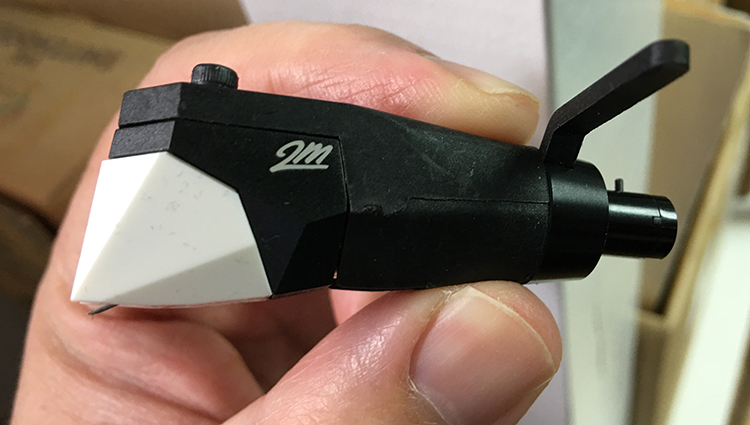
Ortofon 2M Mono MM Cartridge
The Ortofon 2M Mono cartridge, like the 2M Black, also arrived in its PnP version. As its name implies it is designed specifically to play back mono LPs. Mono record grooves are cut having only a lateral (side to side) component for a stylus to track correctly where stereo grooves have both lateral and vertical (45 degree) components. With the exception of the original Edison system which was all vertical, a lot of choices existed on how to deploy the vertical and lateral motions for the first stereo LP. Developers finally settled on a version that would allow a stereo cartridge to play both stereo and mono LPs. This YouTube video helps explain this. While you can use stereo cartridges to play back mono LPs, traditionally one would never use a mono cartridge to read stereo LPs. You could seriously damage both your vinyl and the stylus. If all you want to play is mono then you want a cartridge that only senses lateral groove movement. In the old days for mono you would have only two pins out the back of the cartridge and use one side of the RIAA. According to Louis Dorio, Product Specialist at Ortofon “the 2M Mono uses a strapped output to deliver the same output signal from both sets of pole pins. This is a matter of convenience to enjoy mono records in the easiest way possible, which is why the same signal is then distributed from both sets of pole pins. Most modern mono cartridges do just this, saving any hassle of rewiring a system every time when mono is played. Mono tends to be a lot less convenient to implement for many, so this method is our contribution to helping ease that. So, to sum it up, the suspension is taken from a stereo design, but the coil layout offers the true mono performance and then we bridge the output.” The Ortofon 2M Mono PnP retails $398.00, with the standard mount version costing $356.00. This is the first time that I’ve used a mono-only cartridge and I have to say that it has opened my eyes (and ears) and reminded me of the old axiom “use the right tool for the job”. Whether I was playing my old Les Paul & Mary Ford Capitol 45s, a DECCA Andres Segovia LP, Capitol’s Meet The Beatles, or some other mono LPs, the results were uniformly the same: increased clarity and a far lower level of surface noise than when using a stereo cartridge. As contrary as this sounds, I found that using a mono cartridge actually gave more dimension to the audio produced from these mono records than I’d ever heard before. I’m not a musical historian or archivist by any stretch and these records are obviously not “audiophile” material but I have to say listening to them through a good system with a proper cartridge gave me such an unexpected level of satisfaction and gratification. It was honestly the biggest surprise of this whole review. While I also have some 78 RPM shellac records, Ortofon informed me that the 2M Mono is not properly suited for 78 playback. I still played some 78 Merle Travis and Les Paul shellacs with it and while it worked Ortofon suggested instead that they send a 2M 78 cartridge for me to get the proper measure how 78s should be played. I’ll publish a little follow up on that once I’ve had a chance to try it out.
Some of the musical selections that I found particularly interesting and enjoyable in my time with the Technics SL1500C Turntable were:
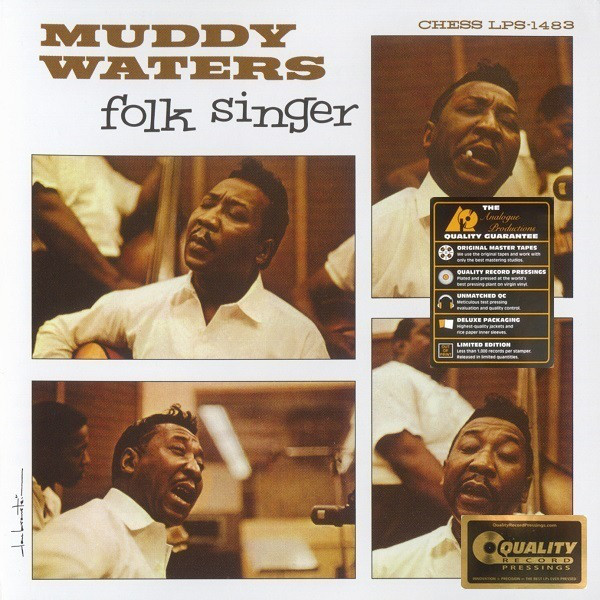
Muddy Waters, Folk Singer
Muddy Waters “Folk Singer”
Chess/Analogue Productions, LPS 1483, 2015.
A Chess Records classic. A stripped-down and completely acoustic blues recording nicely remastered and released on 200-gram vinyl by Analogue Productions. The Technics SL1500C went about its business silently and precisely spinning this disk while the Ortofon 2M Red did yeoman’s work reproducing the depth and echo of Muddy Water’s vocals. Willie Dixon’s bass lines and some of the deep acoustic guitar resonance and slap-echo sounded particularly tasty on the tracks “Country Boy” and “Feel Like Going Home”. The latter track had the 2M Red pulling some nice detail out of the guitar slide as it worked the strings.
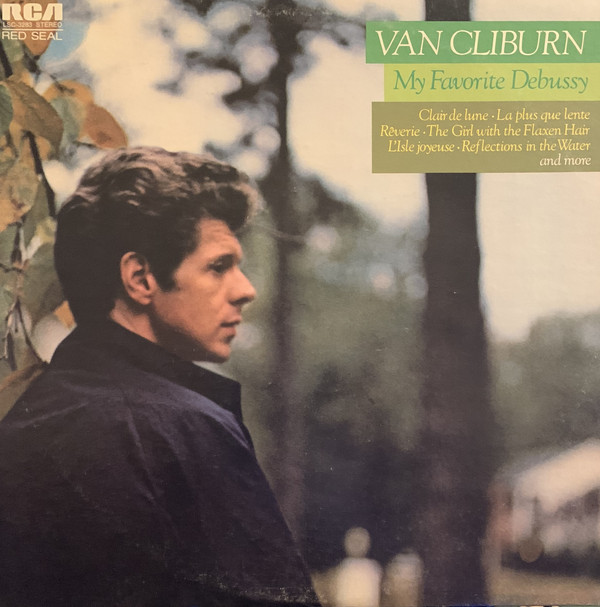
Van Cliburn, My Favorite Debussy
Van Cliburn “My Favorite Debussy”
RCA Red Seal, LSC-3283, 1972.
A nicely recorded solo piano album. Of the two stereo cartridges, the 2M Black decisively ran away with this one on almost every level. Not an unexpected result given the price difference between the two cartridges. The ringing and decay of the piano notes were noticeably more vibrant and superior to the 2M Red. Cliburn’s piano playing was especially detailed and just sparkled more while listening through the 2M Black. Then there was the bigger sense of imaging overall with the Black. The one place where the 2M Red sounded possibly better than the Black was in the lower register piano notes.
To my ears, they had more impact and authority when played back with the Red. The other thing worth mentioning is that the onboard phono preamp on the SL1500C did especially good with this album. The piano is notoriously tricky to reproduce properly and I used this album to compare the sound of SL1500C’s phono preamp to my Rotel RQ-970BX and the Anthem STR preamp’s MM section. All three sounded equally good to me.
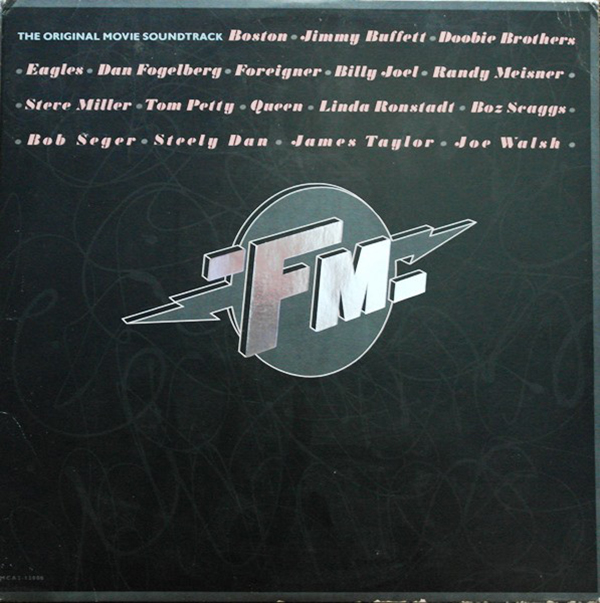
FM-The Original Motion Picture Soundtrack, MCA Records
Various Artists “FM-The Original Motion Picture Soundtrack”
MCA Records, MCA2-12000, 1978.
This is just a great album chock full of music I grew up with and it all sounds nicely mastered given the variety of material on this 2 LP set (Thank you, Gary Katz). Classic rock and pop seemed to work well for both the Ortofon 2M Black and Red. The sonic differences between the cartridges with this material were still there but more subtle. My notes said things like “2M Red has more punch at the beginning intro to Life In the Fast Lane”. “Do It Again sounds a little bigger and wider with 2M Black”, “Linda Ronstadt’s voice sounds a little cleaner and sweeter with the Black on Tumbling Dice.”
You get where this is going. It’s more a matter of degrees with this type of music. I could see a case where if you have speakers with an elevated top-end response, one may prefer the overall balance of the 2M Red whereas if your speakers follow the HARMAN curve method of thinking, the 2M Black’s response may give you better results. Now $99.00 (2M Red) compared to $839.00 (2M Black) is a huge price differential and while Ortofon does offer the 2M Blue and 2M Bronze to bridge that gap, if I had to recommend a cartridge that was a suitable intermediate-point, I would wholeheartedly choose the Audio-Technica VM540ML. It gives you much of what the 2M Black offers (including slight better distortion performance) for less than half the price.

Herb Alpert’s Tijuana Brass /Whipped Cream and Other Delights
Herb Alpert’s Tijuana Brass “Whipped Cream and Other Delights”
A&M Records, LP-110 (Mono), 1965.
So why is this classic bit of Latin Jazz kitsch one of my examples of enjoyable selections? Of all the mono records I played, this one had the most surprising improvement when using a dedicated mono stylus over a stereo one. The sonic improvements in playing any of the old mono 45 singles or 33 LPs that I have were quite obvious. My Les Paul and Mary Ford 45s were a wonder to listen to with the 2M Mono cartridge exhibiting much lower noise and sounding clearer than when using the other two Ortofons.
I just didn’t expect “Whipped Cream and Other Delights” to exhibit the same degree of improvement, being a comparatively more modern recording, but it certainly did to my surprise. Listening to “A Taste of Honey” through a Stereo cart just sounds one-dimensional. The highs are flattened out and the whole presentation just sounds “blah.” If it was possible to listen to a photocopy, that’s what I would liken it to. Using the 2M Mono opens everything up. The horns sound more lively and the entire performance just pops more while surface noise noticeably drops. I usually would be disappointed when I came across a mono recording of an album I was interested in. The Ortofon 2M Mono takes that frown and turns it upside down as it were. I may have to revisit some of my old mono Sinatra LPs…
The Technics SL1500C was tested with both the Ortofon 2M Red and 2M Black cartridges. The 2M Mono was not bench tested as I do not have any strictly mono test material to use for it and using my existing test discs with it would certainly cause them damage. The turntable was connected to a Rotel RQ-970BX phono stage. The CBS STR 100 and STR 112 Test LPs were used for the following tests. Measurements were taken with a VTF of 1.8 grams (2M Red) and 1.5 grams (2M Black) applied to the cartridges as recommended by the manufacturer. We will feature the frequency response, distortion and channel separation results for both cartridges now and will release separate addendums for each cartridge with additional test results (for those who want to get into the nitty-gritty) at a later date.

Technics SL1500C /Ortofon 2M Red Frequency Response and Crosstalk
This chart shows the frequency response and channel separation measurements of the Technics SL1500C /Ortofon 2M Red combination. While the response remains flat for most of the bass and midrange frequencies, this cartridge runs about 2 dB hot at 20 Hz before flattening out by 30 Hz. The response remains linear until 3 kHz where we begin a steady and gradual rolling off until we’re at -6 and -8 dB at 20 kHz. The Left and Right channels stay fairly close together with a minor divergence between 12 to 14 kHz. The channel separation components seem to stay about 5 dB apart through most of the range.
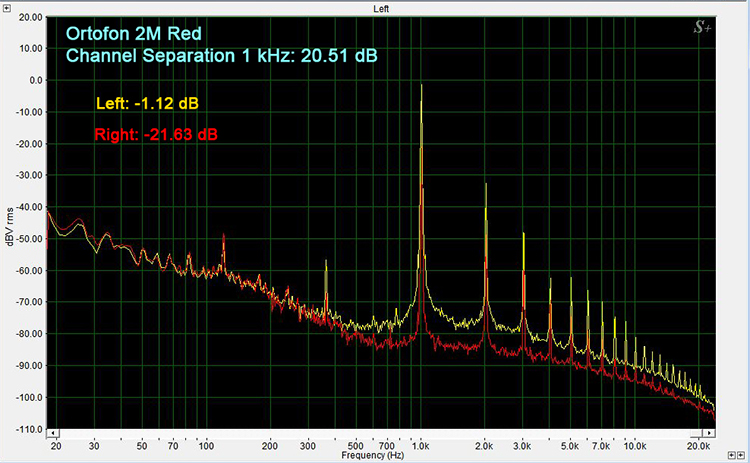
Technics SL1500C /Ortofon 2M Red Channel Separation 1 kHz
The measured channel separation for the Ortofon 2M Red at 1 kHz is 20.51 dB.
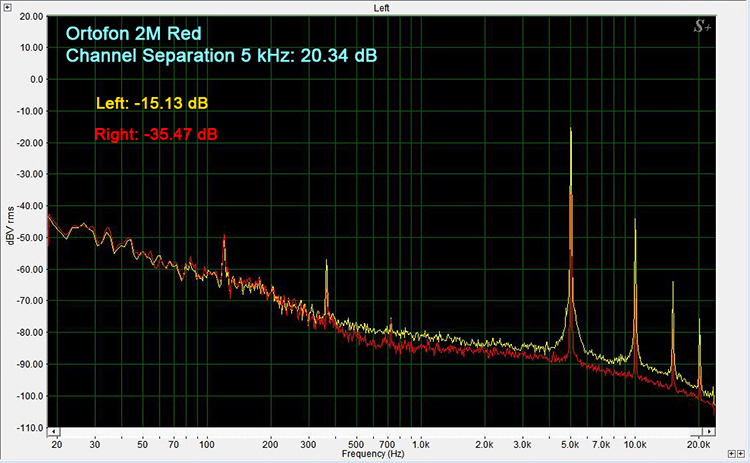
Technics SL1500C /Ortofon 2M Red Channel Separation 5 kHz
The measured channel separation for the 2M Red at 5 kHz is 20.34 dB.
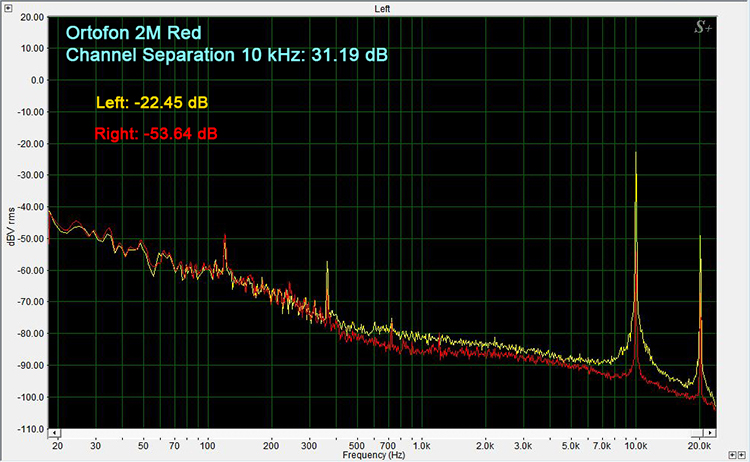
Technics SL1500C /Ortofon 2M Red Channel Separation 10 kHz
The measured channel separation for the 2M Red at 10 kHz is 31.19 dB.
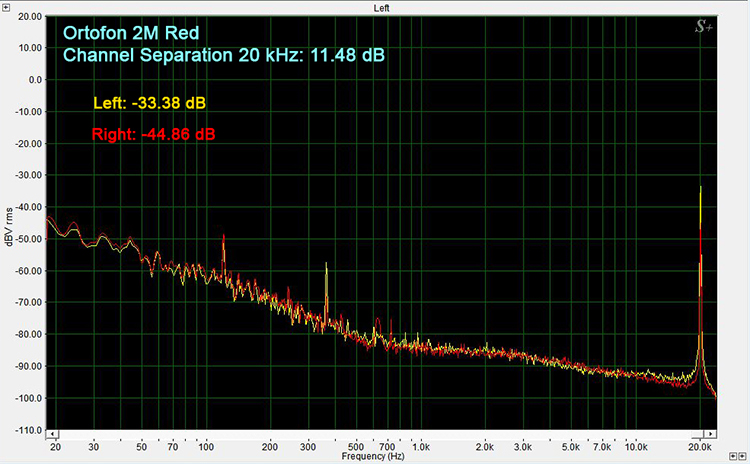
Technics SL1500C /Ortofon 2M Red Channel Separation 20 kHz
The measured channel separation for the 2M Red at 20 kHz is 11.48 dB.

Technics SL1500C /Ortofon 2M Red Worst-Case THD 1 kHz
Here is the 1 kHz THD measurement for the Technics SL1500C /2M Red combo. While we show figures for both channels, the higher number is the one that gets reported, hence the worst-case. In this instance, it’s the left channel with a THD of 1.71%. This is higher value that what one would expect. We typically look for values of 0.6% and lower.
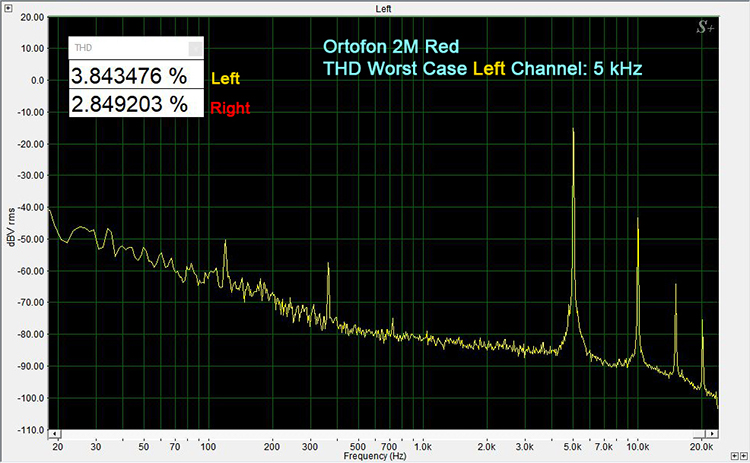
Technics SL1500C /Ortofon 2M Red Worst-Case THD 5 kHz
The 5 kHz THD measurement for the Technics /2M Red combo shows a worst-case figure in the left channel of 3.84%.

Technics SL1500C /Ortofon 2M Red Worst-Case THD 10 kHz
The 10 kHz THD measurement for the Technics /2M Red combo shows a worst-case figure in the right channel of 4.60%. This is consistent with the distortion performance of Elliptical styli at higher frequencies.
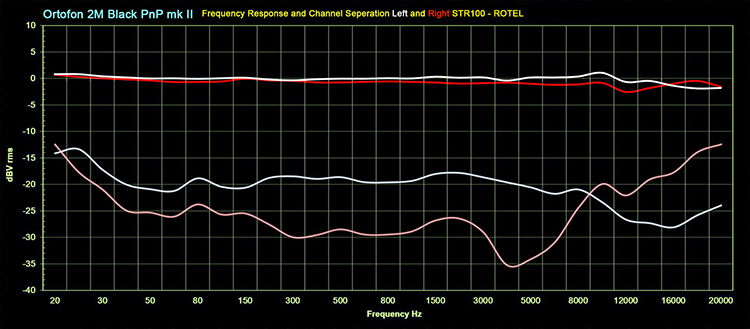
Technics SL1500C /Ortofon 2M Black Frequency Response and Crosstalk
This chart shows the frequency response and channel separation measurements of the Technics SL1500C /Ortofon 2M Black combination. The overall response is commendably flat for most of the frequency range. There is a 2 dB deviation between Left and Right channel traces from 5 kHz on up. The channel separation components seem to stay about 10 dB apart through most of the midrange and treble regions.
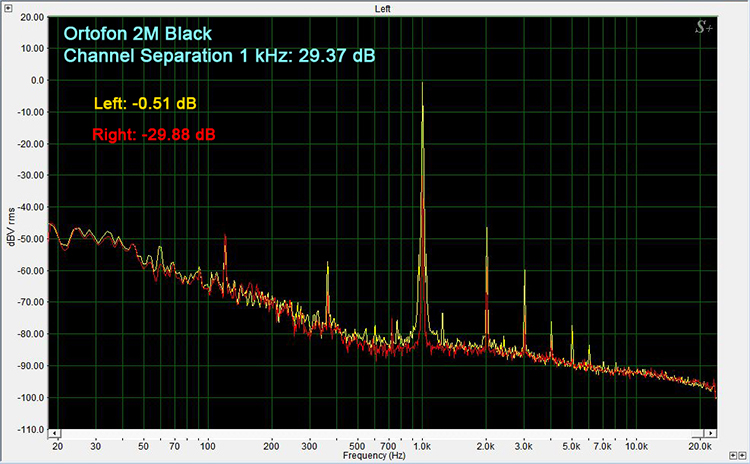
Technics SL1500C /Ortofon 2M Black Channel Separation 1 kHz
The measured channel separation for the Ortofon 2M Black at 1 kHz is 29.37 dB. This figure is over 3 dB better than what Ortofon specs for this cartridge at that frequency.
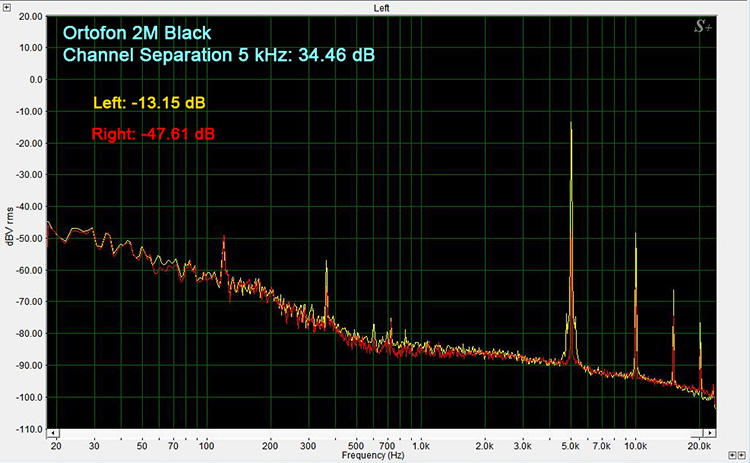
Technics SL1500C /Ortofon 2M Black Channel Separation 5 kHz
The measured channel separation for the 2M Black at 5 kHz is 34.46 dB.
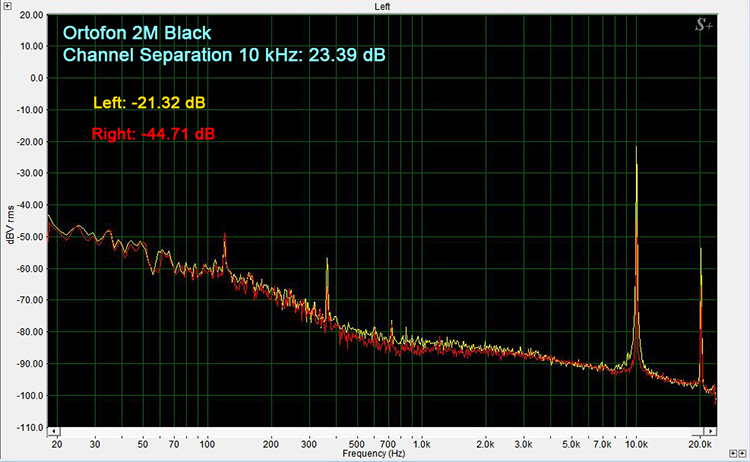
Technics SL1500C /Ortofon 2M Black Channel Separation 10 kHz
The measured channel separation for the 2M Black at 10 kHz is 23.39 dB.

Technics SL1500C /Ortofon 2M Black Channel Separation 20 kHz
The measured channel separation for the 2M Black at 20 kHz is 10.71 dB.
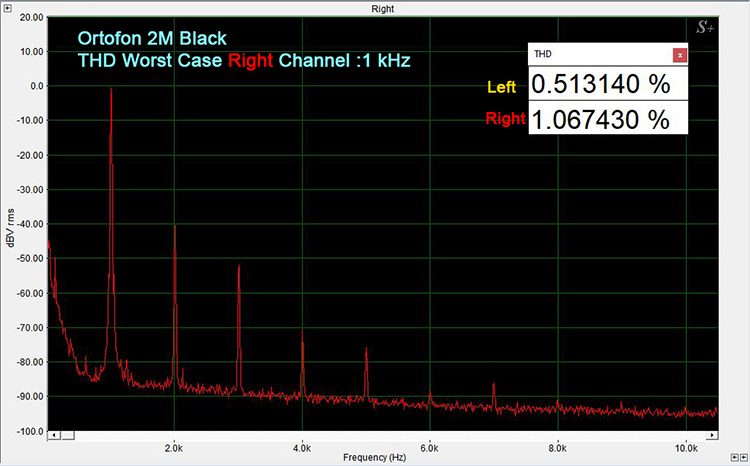
Technics SL1500C /Ortofon 2M Black Worst-Case THD 1 kHz
Here is the 1 kHz THD measurement for the Technics /2M Black combo. While we show figures for both channels, the higher number is the one that gets reported, hence the worst-case. In this instance, it’s the right channel with a THD of 1.07%. Again, this is a little higher than what we’d like to see at this frequency.
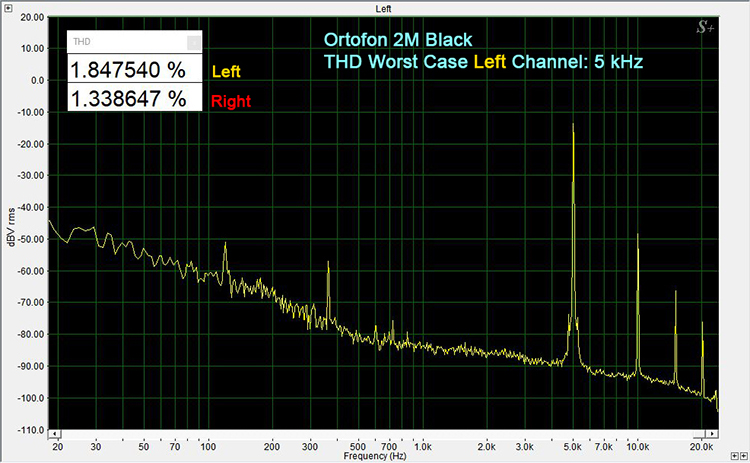
Technics SL1500C /Ortofon 2M Black Worst-Case THD 5 kHz
The 5 kHz THD measurement for the Technics /2M Black combo shows a worst-case figure in the left channel of 1.85%.
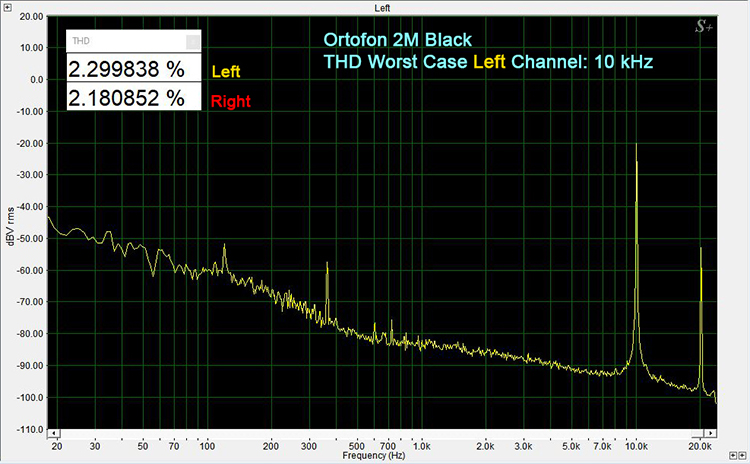
Technics SL1500C /Ortofon 2M Black Worst-Case THD 10 kHz
The 10 kHz THD measurement for the Technics /2M Black combo shows a worst-case figure in the left channel of 2.30%.
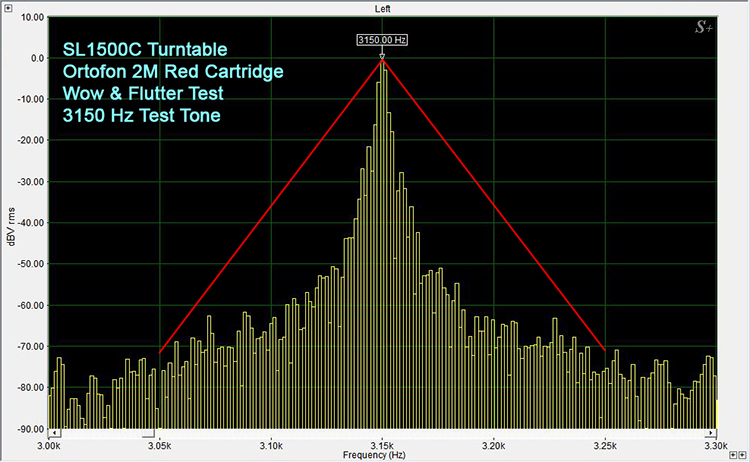
Technics SL1500C Wow & Flutter Test
The 33-1/3 RPM Wow & Flutter test, above, shows no flutter out to the extreme ends of the spectrum which is outside the imaginary diagonal line that would be drawn from the peak down to the 3,050 Hz point and 3,250 Hz point.
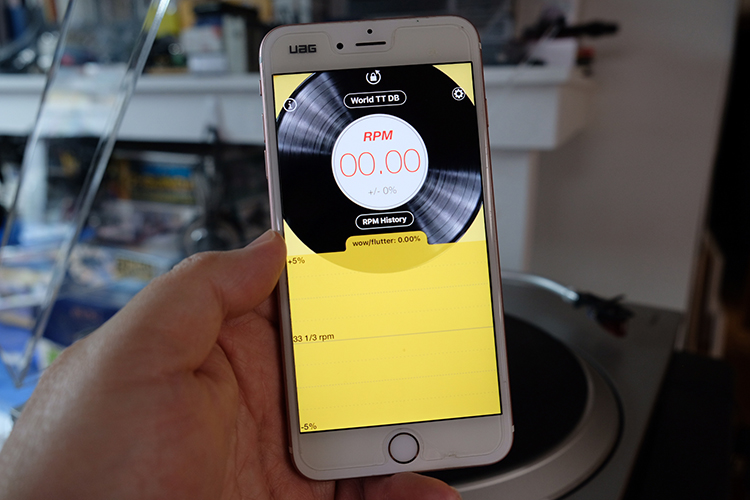
RPM Test App 1
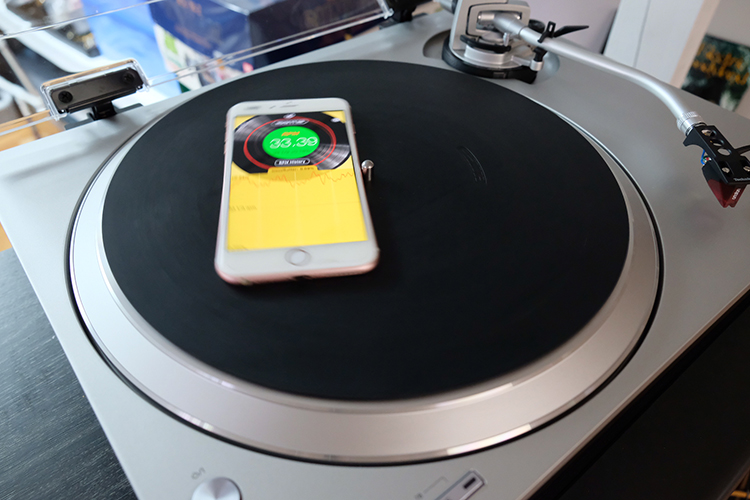
RPM Test App 2
Using the smartphone-based app “RPM” which takes advantage of a smartphone’s internal gyroscope to measure platter speed, the Technics SL1500C showed a speed of 33.36 rpm which translates to a 0.07% speed error. The app also reports the turntable’s Wow & Flutter at 0.13%. For comparison I show an RPM result from my SL1200 table with a 0.06% speed error and 0.16% Wow & Flutter result. I also show a result from a comparably priced belt-drive turntable with a speed error of 0.23% and Wow & Flutter of 0.25%.
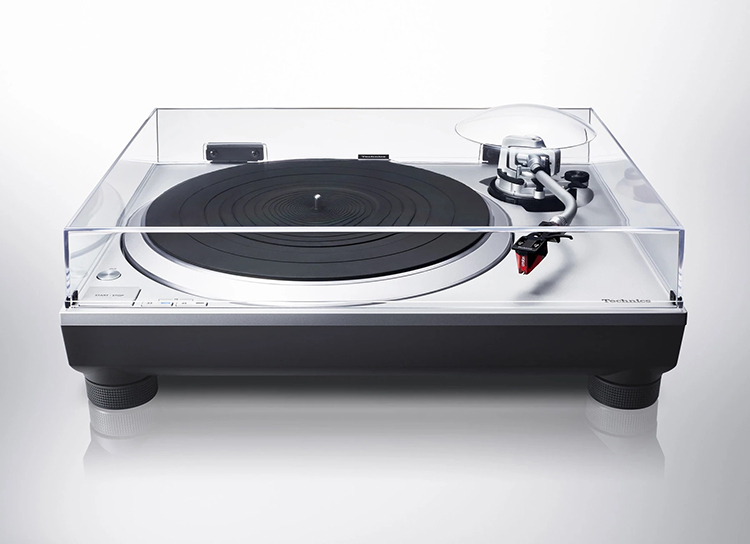
Technics SL1500C
The Technics SL1500C is very likely the only turntable most people will ever need and you will not find any better new turntable for its price, period. Highly recommended.
- Advanced Direct -Drive system.
- Easy to set up and use.
- Solidly built.
- Bundled with a nice Ortofon MM Cartridge.
- Built-in phono preamp.
- Revised cueing arm/tonearm travel.
The Technics SL1500C turntable is an outstanding performer for its price class, and then some. It distills and refines all the elements that made the original SL1200 turntables such a favorite with Hi-Fi enthusiasts and does away with the more DJ-centric features that are now available in the purpose-built SL1200 Mk 7. At $1199.99, with a modern direct-drive system, a fine-sounding Ortofon 2M Red cartridge, and a more than capable built-in MM phono preamp, the SL1500C is almost a “no-brainer” purchase for someone who is looking for a turntable at this price point. Yes, the auto-lift tonearm feature is a little indecisive and the action of the cueing arm annoys me. All the turntables I’ve seen at this price point have cueing arms that unfortunately act and feel the same way, so I do wish the SL1500C stood out better in this regard. Still, If your heart is set on a nice quality belt drive table (and there are some nice ones at this level to be had out there) then this whole discussion is moot. But if you want your records to be spun by something a little more advanced than a rubber band, or you always liked the idea of owning an old SL1200, the SL1500C has you covered every which way from Sunday. Don’t bother with the knock offs or the SL1200 wannabe tables out there, you know you’ll only use the pitch control and strobe light to show off to your friends. Go for the legit “Son of Kong”. As The Who used to sing “Meet the new boss, same as the old boss.”


